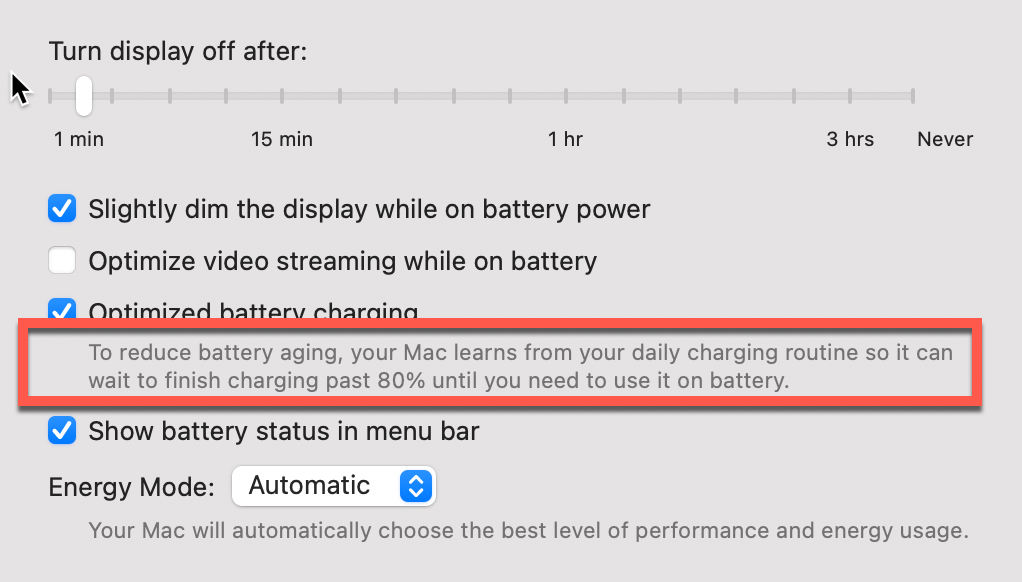- October 31, 2022
- Posted by: Dave Kurlan
- Category: Understanding the Sales Force

My MacBook Pro is running Monterey version 12.6 and it has been charging to only 80%. This was driving me crazy so I did some digging and found that the default battery setting is “Optimized” where it says the following: “To reduce battery aging, your Mac learns from your daily charging routine so it can wait to finish charging past 80% until you need to use it on battery.”

I’m not the smartest person when it comes to topics other than sales or baseball, but my take is that when plugged in, it will remain 80% charged until I need it to run on battery, at which time it will obviously begin draining – to less than 80%. This suggests that it will never charge to 100%! It’s not intuitive and takes some decoding.
When interviewing sales and sales leadership candidates, similar counter-intuitive discussions occur. Many candidates claim that money isn’t that important because they love sales – until they claim that the base salary isn’t high enough. For others, even though they may not disclose it, the base salary is completely irrelevant as long as the company won’t cap the salesperson’s total earnings. We need to decode the topic of compensation so that we can be sure that both the base salary and the total on-plan earnings are acceptable to candidates.
It is very important to make sense of the hidden and unpredictable compensation responses because many salespeople leave the company after a short time because they don’t believe earnings are equivalent to the compensation that was promised.
It is crucial to understand that salespeople are motivated primarily by one of two motivational styles and unless you wish to hire only one type of salesperson, there must be two compensation plans that should be tailored accordingly. Let’s discuss this.
Salespeople that are motivated by money are extrinsically motivated. Salespeople who are motivated by something other than money are intrinsically motivated. While neither is better or worse, the largest percentage of extrinsically motivated salespeople are in the top 5% of all salespeople. A small percentage of salespeople are altruistically motivated and simply want to be of service. Generally speaking, that is the department they belong in – the Customer Service department. The largest percentage of altruistically motivated salespeople are found in the bottom 10% of all salespeople.
The majority of both extrinsic and intrinsic salespeople are motivated and you can continue to motivate them, but compensation plans for each group should be appropriately tailored. Intrinsically motivated salespeople don’t want less money, they want more security from their base salary. Extrinsically motivated salespeople don’t need a larger base salary, they want the ability to maximize their earnings without a cap.
The most recent data from Objective Management Group (OMG) shows that only 23% of all salespeople are extrinsically motivated, down from 25% in 2017 and from 59% in 2005. Ironically, while most compensation plans are geared towards this group, the largest percentage of salespeople are intrinsic!
While the motivational style represents how salespeople are motivated, the motivational score tells us the degree to which salespeople are motivated. The score varies slightly around the world as it is 93% in Latin America, 82% in Europe, 89% is Asia, 83% in Oceana, 95% in Africa, and 88% in the United States.
The score also varies by years of sales experience where, for the most part, years of sales experience correlates to age demographics. For example, those with fewer than 3 years of sales experience are also those we expect to be younger salespeople where 84% of that group is motivated. Surprisingly, that jumps to 89% for salespeople with more than 5 years of sales experience and holds steady through 30 years of sales experience.
One other Competency score that changes based on experience/age is Commitment to sales success. Only 56% of the salespeople with fewer than 3 years of experience are committed, but that jumps to 64% for those with 5-10 years of experience, 67% for those with 10-20 years of experience and up to 69% for those with 20-30 years of experience.
Why are the oldest and most experienced salespeople more committed? If you have hired younger salespeople, you already know how unlikely they are to stick around for more than 1-2 years and how few of them succeed!
If you look at Commitment and Motivation by sales proficiency or percentile, Commitment and Motivation become even clearer. 100% of the top 10% of all salespeople are both committed and motivated. Compare that to the bottom 10% where only 13% are committed and only 20% are motivated. The top 10% are 606% more committed and motivated than the bottom 10%! When we look at the weakest 50%, we learn that only 39% are committed and 76% are motivated. As you can probably guess, motivation won’t get the job done when a salesperson is not committed to sales success.
Understanding how a salesperson is motivated is the key to aligning your compensation plan, but knowing a salesperson’s level of Commitment is one of the key competencies to predict sales performance and success.
Motivation and Commitment are two of the 21 Sales Core Competencies measured by OMG so when you use OMG’s Sales Candidate Assessments these two important findings are no longer a hidden secret.
Contact Us to Get Started with our Help.
Image copyright 123RF
